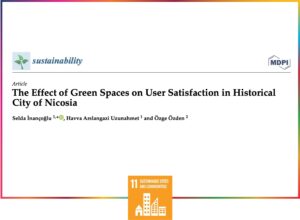
A team of researchers from Near East University has conducted a study addressing the significance of Urban Green Spaces (UGS) in the historical context of cities, particularly focusing on Nicosia. The research aimed to assess the impact of UGS on the historical urban texture by measuring user satisfaction, aligning with the objectives of Sustainable Development Goal 11 (SDG 11) – Sustainable Cities and Communities.
The study, conducted in the rich historical texture of Nicosia, emphasized the crucial role of UGS in ensuring the sustainability of cities. Utilizing a combination of literature review, fieldwork, and advanced computer programs, the researchers evaluated the existence, functionality, and contribution of UGS to the urban fabric. A survey method based on functional factors was then employed to measure user satisfaction, with results statistically evaluated using the Statistical Package for Social Sciences (SPSS) 26.0 software and the Pearson’s chi-squared test.
The findings revealed that, despite the presence of UGS, they were limited in certain regions, and their functions were not effectively utilized. User satisfaction surveys indicated that existing green areas in the old city of Nicosia were insufficient, lacking cleanliness, safety, shading plants, and proper maintenance. The study highlighted the necessity for proper planning in future urban developments to incorporate green areas of sufficient scale in historical city fabrics.
The researchers underscored the multidimensional benefits of UGS, encompassing health, environmental, social, and economic factors, aligning with SDG 11’s aim to make cities inclusive, safe, resilient, and sustainable. The study emphasized the need for local governments to develop plans that enhance the impact of UGS functions and benefits in historical cities.
In the face of climate change and global warming, the researchers emphasized the increased importance of green areas in both newly formed and old cities. Urban planners and policymakers were urged to address the unbalanced provision of green spaces, ensuring ecological justice and enhancing the quality of city life. The study concluded with a call for comprehensive plans in future developments to integrate sufficient green areas into the urban fabric, contributing to the realization of sustainable and resilient cities as outlined in SDG 11.
More Information:
https://www.mdpi.com/2071-1050/15/16/12198